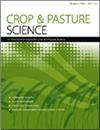五种热带禾草产量和梢部性状对氮素和离树距离的差异响应
IF 1.8
4区 农林科学
Q2 AGRICULTURE, MULTIDISCIPLINARY
引用次数: 0
摘要
光照强度和氮素有效性是影响C4牧草生长的重要因素。物种对遮阳和氮输入的适应性反应可能会发生权衡,而功能性芽部性状可以帮助解释这些反应对物种表现的影响。本研究的目的是了解当资源、光照和氮素均发生变化时,草的茎部性状决定地上部干物质产量(DMY)的机制。方法5种C4多年生牧草在6种遮荫条件下生长(全光照和桉树行间5个位置),2种氮素水平(0和300kgNha−1年−1年),在冠层截光达到95%时进行刈割。通过通径分析,探讨DMY、遮荫水平、氮营养指数与地上部性状之间的关系。施氮可使产量增加126 ~ 569g干物质m−2。植株氮浓度是DMY最重要的预测因子。增加遮阳每增加1%,DMY降低6.94-12.5g干物质m−2。比叶面积、鞘长和叶面积指数(通过叶面积和分蘖密度)也能调节DMY,但因种而异。结论所比较的5种植物在茎部性状方面采取了不同的机制,揭示了不同的应对光和氮有效性变化的策略。农林业从业者可能希望选择更有可能在树木生长时保持生物量产量的牧草。本文章由计算机程序翻译,如有差异,请以英文原文为准。
Differential responses of yield and shoot traits of five tropical grasses to nitrogen and distance to trees in silvopastoral systems
Context Light intensity and nitrogen availability are important factors influencing the growth of C4 forage species. Trade-offs may occur in the adaptive responses of species to shading and nitrogen inputs, and functional shoot traits can help to explain the consequences of these responses for species performance.Aims Our objective was to gain understanding of the mechanisms involving shoot traits of grasses that determine above-ground dry matter yield (DMY) when resources, light and nitrogen all vary.Methods Five C4 perennial forage grasses were grown in six shading conditions (full sunlight vs five positions between Eucalyptus dunnii rows) with two nitrogen levels (0vs 300kgNha−1year−1) and clipped when the canopy reached 95% light interception. Path analysis was used to explore the relationship between DMY, shading levels, nitrogen nutrition index and shoot traits.Key results Yield increased between 126 and 569g dry matter m−2 with nitrogen fertilisation. Plant nitrogen concentration was the most important predictor of DMY. Increased shading reduced DMY by 6.94–12.5g dry matter m−2 for each 1% increase in shading. DMY was also modulated by shoot traits such as specific leaf area, sheath length and leaf area index (via leaf area and tiller density), but with different responses according to species.Conclusions The five species compared adopted different mechanisms involving shoot traits, revealing different strategies to cope with changes in light and nitrogen availability.Implications Agroforestry practitioners may want to choose forages that are more likely to maintain biomass yield as trees grow.
求助全文
通过发布文献求助,成功后即可免费获取论文全文。
去求助
来源期刊

Crop & Pasture Science
AGRICULTURE, MULTIDISCIPLINARY-
CiteScore
4.20
自引率
15.80%
发文量
111
审稿时长
3 months
期刊介绍:
Crop and Pasture Science (formerly known as Australian Journal of Agricultural Research) is an international journal publishing outcomes of strategic research in crop and pasture sciences and the sustainability of farming systems. The primary focus is broad-scale cereals, grain legumes, oilseeds and pastures. Articles are encouraged that advance understanding in plant-based agricultural systems through the use of well-defined and original aims designed to test a hypothesis, innovative and rigorous experimental design, and strong interpretation. The journal embraces experimental approaches from molecular level to whole systems, and the research must present novel findings and progress the science of agriculture.
Crop and Pasture Science is read by agricultural scientists and plant biologists, industry, administrators, policy-makers, and others with an interest in the challenges and opportunities facing world agricultural production.
Crop and Pasture Science is published with the endorsement of the Commonwealth Scientific and Industrial Research Organisation (CSIRO) and the Australian Academy of Science.
 求助内容:
求助内容: 应助结果提醒方式:
应助结果提醒方式:


